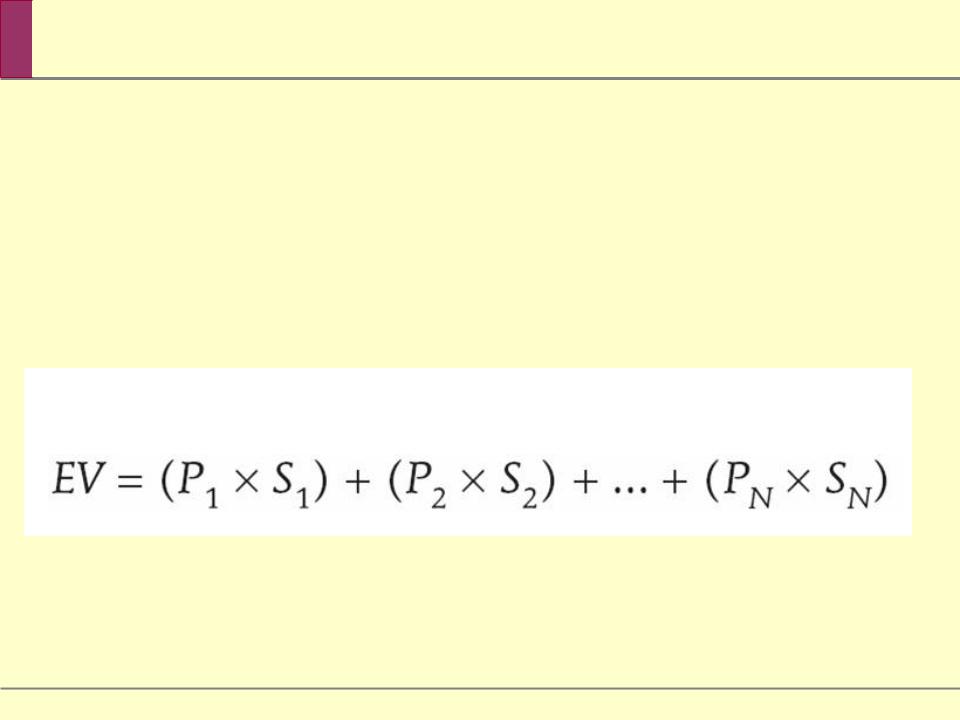
Lectures_micro / Microeconomics_presentation_Chapter_21
.pdf
chapter:
21
>>Uncertainty, Risk and Private Information
Krugman/Wells
Economics
©2009 Worth Publishers

WHAT YOU WILL LEARN IN THIS CHAPTER
That risk is an important feature of the economy, and that most people are risk-averse.
Why diminishing marginal utility makes people riskaverse and determines how much premium they are willing to pay to reduce risk
How risk can be traded, with risk-averse people paying others to assume part of their risk
How exposure to risk can be reduced through diversification and pooling
How special problems are posed by private information—situations in which some people know things that other people do not


 The Economics of Risk Aversion
The Economics of Risk Aversion
In general, people don’t like risk and are willing to pay a price to avoid it.
But what exactly is risk? And why don’t people like it?
To answer these questions, we need to look briefly at the concept of expected value and the meaning of uncertainty.


 Expectations and Uncertainty
Expectations and Uncertainty
A random variable is a variable with an uncertain future value.
e.g. a person’s medical expenses for the coming year.
Let’s assume that there’s a 50 percent chance that this person will get sick and his high medical expenses will materialize.
He may face medical expenses of $10,000.


 Expectations and Uncertainty
Expectations and Uncertainty
The expected value of a random variable is the weighted average of all possible values, where the weights on each possible value correspond to the probability of that value occurring.
In this example, the expected value of the medical expenses is:
(0.5 × $0) + (0.5 × $10,000) = $5,000


 Expectations and Uncertainty
Expectations and Uncertainty
To derive the general formula for the expected value of a random variable, we imagine that there are a number of different states of the world.
A state of the world is a possible future event.
Then the expected value of the random variable is:


 Expectations and Uncertainty
Expectations and Uncertainty
Risk is uncertainty about future outcomes. Most people prefer, other things equal, to reduce risk.
We’ll focus here on financial risk, in which the uncertainty is about monetary outcomes, as opposed to uncertainty about outcomes that can’t be assigned a monetary value.
But, why do people feel that risk is a bad thing?


 The Logic of Risk Aversion
The Logic of Risk Aversion
The answer to the question of why people feel that risk is a bad thing lies in the concept of diminishing marginal utility.
To understand how diminishing marginal utility gives rise to risk aversion, we need to look not only at the medical costs but also at how those costs affect the income the family has left after medical expenses.
If we assume that the family income is $30,000, the expected income after medical expenses is:
(0.5 × $30,000) + (0.5 × $20,000) = $25,000.


 The Logic of Risk Aversion
The Logic of Risk Aversion
Expected utility is the expected value of an individual’s total utility given uncertainty about future outcomes.
Expected utility of the family is less than it would be if the family didn’t face any risk and knew with certainty that its income after medical expenses would be $25,000.
The following graph and table illustrates this point
more clearly...

Function
Family
Utility
Utility in state S, US
Income |
Total Utility |
|
(utils) |
||
|
22,000 |
968 |
23,000 |
989 |
24,000 |
1,008 |
25,000 |
1,025 |
26,000 |
1,040 |
27,000 |
1,053 |
28,000 |
1,064 |
29,000 |
1,073 |
30,000 |
1,080 |
Marginal utility in state H
